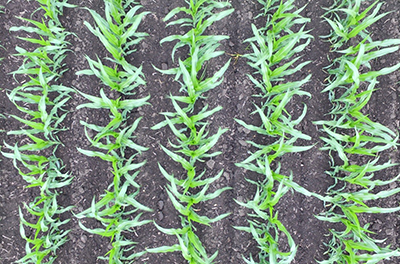By George Silva
High-yield corn research project incorporates modern corn hybrids with non-limiting plant populations and delayed nitrogen treatments.
Michigan State University Extension and DEKALB/Asgrow brands of Monsanto Company in Mason, Michigan, are collaborating on a research project to maximize corn yields. Two semi flex-ear type hybrids, DKC54-38RIB and DKC55-20RIB, are being tested at two seeding rates of 32,000 and 38,000 seeds per acre, and five nitrogen treatments starting at 160 pounds N per acre.
In the two previous years, static nitrogen treatments of 120 and 240 pounds nitrogen per acre were tested, where 40 pounds nitrogen per acre were applied at planting and the balance sidedressed at V5. In both years we encountered leaching and denitrification losses due to heavy rainfall in June and July following the sidedress application.

Corn plants at V5 at 32,000 plants per acre. Photos: George Silva, MSU Extension.
In 2016, in addition to static nitrogen treatments, we have included some nitrogen treatments with the emphasis on extending the nitrogen sidedress window, as predicted by the web-based Climate Fieldview Pro Nitrogen Advisor model. This model will track the level and movement of nitrogen based on soil type, initial nitrogen application rate, rainfall and other climatic conditions across the entire growing season. It will be a guide to the rate and timing for optimal late-season nitrogen applications based on yield target and profit goals. In 2016, we expect split nitrogen as late as V10 and V14 if needed, based on the model. We have the option to use a Y-drop system to apply nitrogen to tall corn.

Corn plants at V5 at 38,000 plants per acre.
The overall objective is to find how these two hybrids will interact with non-limiting plant populations and nitrogen to produce the highest number of harvestable kernels and grain yield per acre. The research plots are located on a high productive soil at the Mason Technology Center in Ingham County. The trial was planted under ideal weather conditions on May 19. Assuming satisfactory weather conditions to prevail the rest of the growing season, this year may be an opportunity to reach the elusive 300 bushels per acre yield goal. At harvest, ear samples will be analyzed for yield components namely rows per ear, kernels per row and average kernel weights. Testing how these hybrids perform under different input levels will provide valuable data to help growers who wish to apply variable rate technology to planting populations and nitrogen rates in the future.
Achieving 300 bushels per acre under dryland conditions will be a significant milestone for corn producers in terms of profitability. Most recent corn yield contest winners in this area have consistently achieved 300 bushels per acre on irrigated land. We believe that yield goals of above 250 bushels per acre are currently attainable under dryland conditions in Michigan by a combination of new genetics and smart cultural practices.
Source:msu.edu